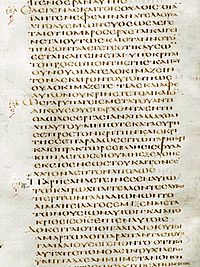Byzantine text-type

In textual criticism of the New Testament, the Byzantine text-type (also called Majority Text, Traditional Text, Ecclesiastical Text, Constantinopolitan Text, Antiocheian Text, or Syrian Text) is one of the main New Testament manuscript text-types. It is the form found in the largest number of surviving manuscripts of the Greek New Testament. The New Testament text of the Eastern Orthodox Church, the Patriarchal Text, as well as those utilized in the lectionaries, are based on this text-type. Whilst varying in at least 1,830 places,[1] it also underlies the Textus Receptus Greek text used for most Reformation-era (Protestant) translations of the New Testament into vernacular languages. Modern translations (since 1900) mainly use Eclectic editions that conform more often to the Alexandrian text-type.
The Byzantine text is also found in a few modern Eastern Orthodox editions, as the Byzantine textual tradition has continued in the Eastern Orthodox Church into the present time. The text used by the Orthodox Church is supported by late minuscule manuscripts. It is commonly accepted as standard Byzantine text.
Manuscripts[]

We have no early witness discoveries of either the Byzantine Text type or the Alexandrian Text type manuscripts that originate from where the original New Testament scriptures were either authored or initially sent to, which was the greater Byzantine area.[citation needed]
The earliest Church Father to witness to a Byzantine text-type in substantial New Testament quotations is John Chrysostom (c. 349 – 407); although the fragmentary surviving works of Asterius the Sophist († 341) have also been considered to conform to the Byzantine text,[2] and the incomplete surviving translation of Wulfila (d. 383) into Gothic is often thought to derive from the Byzantine text type or an intermediary between the Byzantine and Western text types.[3] Chrysostom and Asterius used text only in 75% agreed with the standard Byzantine text. The second earliest translation to witness to a Greek base conforming generally to the Byzantine text in the Gospels is the Syriac Peshitta (though it has many Alexandrian and Western readings);[4] usually dated to the beginning of the 5th century;[5] although in respect of several much contested readings, such as Mark 1:2 and John 1:18, the Peshitta rather supports the Alexandrian witnesses. Dating from the fourth century, and hence possibly earlier than the Peshitta, is the Ethiopic version of the Gospels; best represented by the surviving fifth and sixth century manuscripts of the Garima Gospels and classified by Rochus Zuurmond as "early Byzantine". Zuurmond notes that, especially in the Gospel of John, the form of the early Byzantine text found in the Ethiopic Gospels is quite different from the later Greek Majority Text, and agrees in a number of places with Papyrus 66.[6]
Amongst the bulk of later New Testament manuscripts it is generally possible to demonstrate a clear Byzantine majority reading for each variant; and a Greek New Testament text based on these majority readings—"The Majority Text"—has been produced by Zane C. Hodges and Arthur L. Farstad, although this text does not correspond to any one particular manuscript.
Notable manuscripts[]

| Sign | Name | Date | Content |
| A (02) | Codex Alexandrinus | 5th | Gospels |
| C (04) | Codex Ephraemi Rescriptus | 5th | Gospels (mixed Byzantine/Alexandrian) |
| W (032) | Codex Washingtonianus | 5th | Matt 1-28; Luke 8:13–24:53 |
| Q (026) | Codex Guelferbytanus B | 5th | Luke–John |
| 061 | Uncial 061 | 5th | 1 Tim 3:15-16; 4:1-3; 6:2-8 |
| Ee (07) | Codex Basilensis | 8th | Gospels |
| Fe (09) | Codex Boreelianus | 9th | Gospels |
| Ge (011) | Codex Seidelianus I | 9th | Gospels |
| He (013) | Codex Seidelianus II | 9th | Gospels |
| L (020) | Codex Angelicus | 9th | Acts, CE, Pauline Epistles |
| V (031) | Codex Mosquensis II | 9th | Gospels |
| Y (034) | Codex Macedoniensis | 9th | Gospels |
| Θ (038) | Codex Koridethi | 9th | Gospels (except Mark) |
| S (028) | Codex Vaticanus 354 | 949 | Gospels |
| 1241 | Minuscule 1241 | 12th | only Acts |
| 1424 | Minuscule 1424 | 9th/10th | NT (except Mark) |
Other manuscripts[]
- Papyri